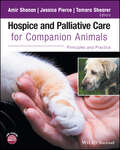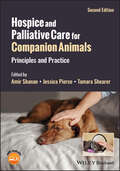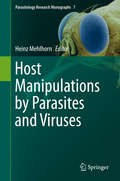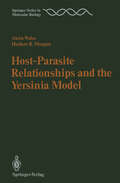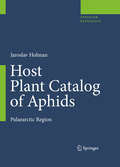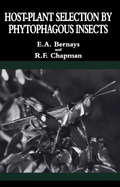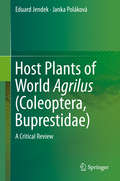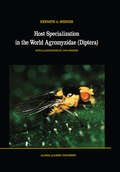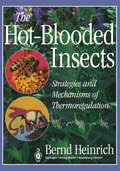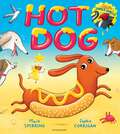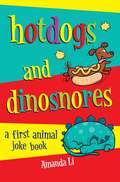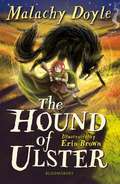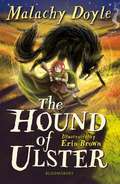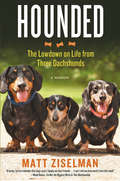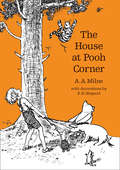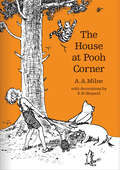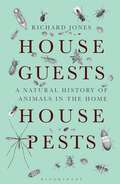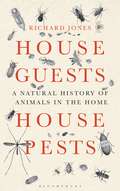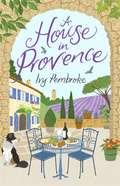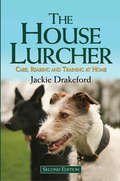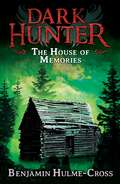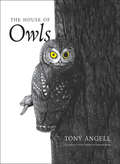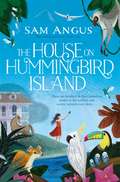- Table View
- List View
Hospice and Palliative Care for Companion Animals: Principles and Practice
by Amir Shanan Jessica Pierce Tamara ShearerHospice and Palliative Care for Companion Animals: Principles and Practice offers the first comprehensive reference to veterinary hospice and palliative care, with practical guidance and best practices for caring for sick and dying animals. Presents the first thorough resource to providing veterinary hospice and palliative care Offers practical guidance and best practices for caring for sick and dying animals Provides an interdisciplinary team approach, from a variety of different perspectives Gives concrete advice for easing pets more gently through their final stage of life Includes access to a companion website with client education handouts to use in practice
Hospice and Palliative Care for Companion Animals: Principles and Practice
by Amir Shanan Jessica Pierce Tamara ShearerHospice and Palliative Care for Companion Animals: Principles and Practice offers the first comprehensive reference to veterinary hospice and palliative care, with practical guidance and best practices for caring for sick and dying animals. Presents the first thorough resource to providing veterinary hospice and palliative care Offers practical guidance and best practices for caring for sick and dying animals Provides an interdisciplinary team approach, from a variety of different perspectives Gives concrete advice for easing pets more gently through their final stage of life Includes access to a companion website with client education handouts to use in practice
Hospice and Palliative Care for Companion Animals: Principles and Practice
by Amir Shanan Jessica Pierce Tamara ShearerHospice and Palliative Care for Companion Animals A thoroughly updated and expanded new edition of the only book providing comprehensive treatment of hospice and palliative care in veterinary medicine Animals with life-limiting illnesses deserve compassionate, thoughtful, end-of-life care. Their caregivers and families, faced with the loss of a beloved companion, deserve empathy, support, and education, to guide them through an emotionally wrenching period and provide their companion animals with the highest possible quality of life. In recent years, the ethics of care and service to sick and dying animals and their caregivers has been the subject of considerable attention. Hospice and Palliative Care for Companion Animals, 2nd Edition provides a thorough update to the first and only complete guide to this field of service, its foundations, and its applications. It addresses the needs of pets, caregivers, and veterinary professionals alike, including fundamental ethical and emotional principles as well as detailed discussion of specific illnesses and life-limiting conditions. The expanded second edition incorporates cutting-edge research into animal behavior and cognition to enrich the reader’s understanding of companion animals’ emotional needs and their experience of illness and death. Hospice and Palliative Care for Companion Animals, 2nd Edition readers will also find: Existing chapters expanded to incorporate new research and practical experience New chapters discussing factors underlying the decision to euthanize, the potential role of ethology in palliative care, and more A companion website with educational handouts for use in veterinary practices Hospice and Palliative Care for Companion Animals is an indispensable resource for caregivers and veterinary professionals alike.
Hospice and Palliative Care for Companion Animals: Principles and Practice
by Amir Shanan Jessica Pierce Tamara ShearerHospice and Palliative Care for Companion Animals A thoroughly updated and expanded new edition of the only book providing comprehensive treatment of hospice and palliative care in veterinary medicine Animals with life-limiting illnesses deserve compassionate, thoughtful, end-of-life care. Their caregivers and families, faced with the loss of a beloved companion, deserve empathy, support, and education, to guide them through an emotionally wrenching period and provide their companion animals with the highest possible quality of life. In recent years, the ethics of care and service to sick and dying animals and their caregivers has been the subject of considerable attention. Hospice and Palliative Care for Companion Animals, 2nd Edition provides a thorough update to the first and only complete guide to this field of service, its foundations, and its applications. It addresses the needs of pets, caregivers, and veterinary professionals alike, including fundamental ethical and emotional principles as well as detailed discussion of specific illnesses and life-limiting conditions. The expanded second edition incorporates cutting-edge research into animal behavior and cognition to enrich the reader’s understanding of companion animals’ emotional needs and their experience of illness and death. Hospice and Palliative Care for Companion Animals, 2nd Edition readers will also find: Existing chapters expanded to incorporate new research and practical experience New chapters discussing factors underlying the decision to euthanize, the potential role of ethology in palliative care, and more A companion website with educational handouts for use in veterinary practices Hospice and Palliative Care for Companion Animals is an indispensable resource for caregivers and veterinary professionals alike.
Host Manipulations by Parasites and Viruses (Parasitology Research Monographs #7)
by Heinz MehlhornThis edited volume focuses on parasite-host relationships and the behavioral changes parasites may trigger in their hosts. Parasites have developed strategies which enhance their chances to find a host to survive inside its body and to become most easily transmitted to one another. Many of these parasites influence the host’s behavior by various mechanisms, so that the rate of their transmissions to further hosts becomes considerably enhanced in comparison to that of non-influenced specimens of the same host species. A broad number of recent studies elucidate more and more examples in an extreme spectrum of host-parasite relationships, where successful transmission and /or survival of a parasite inside a host is based on parasite-derived behavioral manipulations of the hosts. In the literature, an increasing numbers of papers appear which prove that these behavioral alterations are based on complicated psychoimmunologic, neuropharmacologic and genomically steered mechanisms. Researchers working in parasitology or behavioral sciences will find this work thought-provoking, instructive and informative.
Host-Parasite Relationships and the Yersinia Model (Springer Series in Molecular and Cell Biology)
by Akira Wake Herbert R. MorganDuring the past few decades we have witnessed an era of remarkable growth in the field of molecular biology. In 1950 very little was known of the chemical constitution of biological systems, the manner in which information was transmitted from one organism to another, or the extent to which the chemical basis of life is unified. The picture today is dramatically different. We have an almost bewildering variety of information detailing many different aspects oflife at the molecular level. These great advances have brought with them some breath-taking insights into the molecular mechanisms used by nature for replicating, distributing and modifying biological information. We have learned a great deal about the chemical and physical nature of the macro molecular nucleic acids and proteins, and the manner in which carbohydrates, lipids and smaller molecules work together to provide the molecular setting of living systems. It might be said that these few decades have replaced a near vacuum of informa tion with a very large surplus. It is in the context of this flood of information that this series of monographs on molecular biology has been organized. The idea is to bring together in one place, between the covers of one book, a concise assessment of the state of the subject in a well-defined field. This will enable the reader to get a sense of historical perspective what is known about the field today - and a description of the frontiers of research where our knowledge is increasing steadily.
Host-Plant Selection by Phytophagous Insects (Contemporary Topics in Entomology #2)
by Elizabeth A. Bernays Reginald F. ChapmanFor more than 20 years insect/plant relations have been a focus for studies in ecology and evolution. The importance of insects as crop pests, and the great potential of insects for the biological control of weeds, have provided further impetus for work in this area. All this attention has resulted in books on various aspects of the topic, and reviews and research papers are abundant. So why write another book? It seems to us that, in the midst of all this activity, behavior has been neglected. We do not mean to suggest that there have not been admirable papers on behavior. The fact that we can write this book attests to that. But we feel that, too often, behavior is relegated to a back seat. In comparison to the major ecological and evolutionary questions, it may seem trivial. Yet the whole process of host-plant selection and host-plant specificity amongst insects depends on behavior, and selection for behavioral differences must be a prime factor in the evolution of host-plant specificity. In writing this book, we hope to draw attention to this central role of behavior and, hopefully, encourage a few students to attack some of the very difficult questions that remain unanswered.
Host Plants of World Agrilus (Coleoptera, Buprestidae): A Critical Review
by Eduard Jendek Janka PolákováThe beetle genus Agrilus has over 3000 species which makes it the most numerous in the Animal Kingdom. Many species are serious pests of plants with high invasive potential. Among them, the notoriously known Agrilus planipennis invaded from Asia to North America where it killed tens of millions of ash trees, caused regulatory agencies to enforce quarantines and cost municipalities, property owners, nursery operators and forest products industries tens of millions of dollars. The monograph provides coherent, comprehensive and critical review on all known host plants for more than 680 Agrilus species. All host plants have assigned the confidence index from 0-3 based on the evaluated reliability which eliminates false records. All original and subsequent references for particular plants are cited at each Agrilus species. Data are organized from both, insect and plant viewpoints. Results are analyzed and illustrated by graphs and diagrams. The main impact of the monograph is seen in entomology, phytopathology, forestry, agriculture ecology and biocontrol.
Host Specialization in the World Agromyzidae (Series Entomologica #45)
by K.A. SpencerPhytophagous insects represent a very particular not really belong to their host plant range. This may group of organisms. Firstly, their number amounts lead to mistaken conclusions especially in regions to more than one quarter of all recent species (ex where only few observations were possible, as well cluding fungi, algae and microbes) and together with as in the case of uncommon insect species. Fourthly, the green plants on which they feed they form al the great majority (99. 4%) of the agromyzid species most one half of all living species described so far. studied show a high degree of host specialization Secondly, their overwhelming majority shows very which makes these insects especially suitable for narrow host plant specialization, that is they feed taxonomic-phylogenetic considerations. only on one or a few, mostly closely related plant With such an enormous amount of data, it may species, a characteristic that led J. H. Fabre to elab have been tempting to draw far-reaching conclu orate the notion of the 'insects' botanical instinct' a sions. However, the author has been very careful in century ago. doing this.
The Hot-Blooded Insects: Strategies and Mechanisms of Thermoregulation
by Bernd Heinrich"From one man's persistent and elegant probing of the temperature biology of bees, we have been led to a deeper understanding of the whole biology of many insect taxa, and of their interactions with ecological and environmental stresses: all who work at the interfaces of physiology, ecology and behaviour have cause to be grateful, and all should certainly read this book." (Trends in Ecology & Evolution) "An outstanding source of information, and can be read with profit and satisfaction by the professional biologist and interested amateur alike." (Nature)
Hot Dog
by Mark SperringFrom the creators of Mince Spies, Santa Jaws and Jingle Smells comes another hilarious romp that's guaranteed to make you laugh this summer!This is the story of a little hot dog who longs for just one thing: to be a REAL dog. But when the Mustard Fairy makes his dreams come true, will he be accepted by the other dogs? Or will he have to fight for his place in the sun?Packed with beaches, sunshine, ice cream and seaside silliness galore, this is THE picture book of the summer!
Hot Dogs and Dinosnores: A First Animal Joke Book
by Amanda LiHot Dogs and Dinosnores is a hilarious, laugh-out-loud joke book stuffed full of funny animal jokes to get kids laughing, from Amanda Li, the author of Jellyphants and Wooly Jumpers.Children love telling jokes to their friends and family, and these jokes are easy to read and easy to remember. Perfect for beginner readers who delight in fun wordplay. What do you call a dog who likes bubble baths? A shampoodle. Why do cats make terrible storytellers? They only have one tail. Where did the kittens go for their school trip? To the mew-seum. What kind of gum do bees chew? Bumblegum.
The Hound of Ulster: A Bloomsbury Reader (Bloomsbury Readers)
by Malachy DoyleA thrilling retelling of the traditional Irish legend of Cúchulainn written by Malachy Doyle.Young Setanta, the son of poor shepherds, is determined to impress the might king of Ulster with his strength and bravery and to join the Red Branch Knights. He could easily beat the other warriors at hurling. He could even triumph over them in a fight. But can he defeat the ferocious hound of Ulster, the smith Culann's menacing guard dog, and prove his worth?This page-turning story from Malachy Doyle, based on the traditional Irish folk tale, has exciting black-and-white illustrations by Erin Brown and is perfect for children who are developing as readers.The Bloomsbury Readers series is packed with brilliant books to get children reading independently in Key Stage 2, with book-banded stories by award-winning authors like double Carnegie Medal winner Geraldine McCaughrean and Waterstones Prize winner Patrice Lawrence covering a wide range of genres and topics. With charming illustrations, ideas for discussion points and online guided reading notes written by the Centre for Literacy in Primary Education (CLPE), this series is ideal for reading both in the classroom and at home. For more information visit www.bloomsburyguidedreading.com.Book Band: Grey (ideal for ages 8+)
The Hound of Ulster: A Bloomsbury Reader (Bloomsbury Readers)
by Malachy DoyleA thrilling retelling of the traditional Irish legend of Cúchulainn written by Malachy Doyle.Young Setanta, the son of poor shepherds, is determined to impress the might king of Ulster with his strength and bravery and to join the Red Branch Knights. He could easily beat the other warriors at hurling. He could even triumph over them in a fight. But can he defeat the ferocious hound of Ulster, the smith Culann's menacing guard dog, and prove his worth?This page-turning story from Malachy Doyle, based on the traditional Irish folk tale, has exciting black-and-white illustrations by Erin Brown and is perfect for children who are developing as readers.The Bloomsbury Readers series is packed with brilliant books to get children reading independently in Key Stage 2, with book-banded stories by award-winning authors like double Carnegie Medal winner Geraldine McCaughrean and Waterstones Prize winner Patrice Lawrence covering a wide range of genres and topics. With charming illustrations, ideas for discussion points and online guided reading notes written by the Centre for Literacy in Primary Education (CLPE), this series is ideal for reading both in the classroom and at home. For more information visit www.bloomsburyguidedreading.com.Book Band: Grey (ideal for ages 8+)
Hounded: The Lowdown on Life from Three Dachshunds
by Matt ZiselmanLiving with three strong-willed, highly individual Dachshunds can be equal parts entertaining, frustrating and rewarding. Just ask Matt Ziselman. Armed with a fresh, creative voice that is unabashedly cranky one moment and profoundly poignant the next, Ziselman mixes hilarious canine stories, with heartfelt reminiscences from his own life, the results of which is a memoir of illuminating life lessons, courtesy of the three thoroughly Teutonic Dachshunds that he shares his life (and couch) with: Baxter, Maya and Molly. Seemingly mundane moments, like Baxter's incessant, neuroses inducing staring, Maya's inexplicable refusal to walk through the front door and Molly's obsessive compulsive love for a torn and tattered blanket become, through Ziselman's insightful eyes, a treasure trove of observations that any dog-lover will appreciate. In a market where Americans spend more than $40 billion a year on their pets, this work of razor-sharp wit and quiet tenderness will reach out and grab readers everywhere by the heartstrings and-quite possibly-their leashes. HOUNDED wraps universal insights in hot-dog-shaped packages, providing true dog lovers with many knowing nods, honest belly laughs and an accurate, warts-and-all reflection of the fascination, wonder and love that they have for their dogs. And that Matt Ziselman obviously has for his.
The House at Pooh Corner (Winnie-the-Pooh – Classic Editions #4)
by A. A. MilneOne day when Pooh Bear had nothing else to do, he thought he would do something, so he went round to Piglet's house to see what Piglet was doing.'
The House at Pooh Corner (Winnie-the-Pooh – Classic Editions)
by A. A. Milne“In that enchanted place on the top of the Forest, a little boy and his Bear will always be playing.”
House Guests, House Pests: A Natural History Of Animals In The Home (Bloomsbury Nature Writing Ser.)
by Richard JonesToday we live in snug, well-furnished houses surrounded by the trappings of a civilised life. But we are not alone – we suffer a constant stream of unwanted visitors. Our houses, our food, our belongings, our very existence are under constant attack from a host of invaders eager to take advantage of our shelter, our food stores and our tasty soft furnishings.From bats in the belfry to beetles in the cellar, moths in the wardrobe and mosquitoes in the bedroom, humans cannot escape the attentions of the animal kingdom. Nature may be red in tooth and claw, but when it's our blood the bedbugs are after, when it's our cereal bowl that's littered with mouse droppings, and when it's our favourite chair that collapses due to woodworm in the legs, it really brings it home the fact that we and our homes are part of nature too.This book represents a 21st century version of the classic Mediaeval bestiary. It poses questions such as where these animals came from, can we live with them, can we get rid of them, and should we? Written in Richard Jones's engaging style and with a funky-retro design, House Guests, House Pests will be a book to treasure.
House Guests, House Pests: A Natural History of Animals in the Home
by Richard JonesToday we live in snug, well-furnished houses surrounded by the trappings of a civilised life. But we are not alone – we suffer a constant stream of unwanted visitors. Our houses, our food, our belongings, our very existence are under constant attack from a host of invaders eager to take advantage of our shelter, our food stores and our tasty soft furnishings.From bats in the belfry to beetles in the cellar, moths in the wardrobe and mosquitoes in the bedroom, humans cannot escape the attentions of the animal kingdom. Nature may be red in tooth and claw, but when it's our blood the bedbugs are after, when it's our cereal bowl that's littered with mouse droppings, and when it's our favourite chair that collapses due to woodworm in the legs, it really brings it home the fact that we and our homes are part of nature too.This book represents a 21st century version of the classic Mediaeval bestiary. It poses questions such as where these animals came from, can we live with them, can we get rid of them, and should we? Written in Richard Jones's engaging style and with a funky-retro design, House Guests, House Pests will be a book to treasure.
A House in Provence
by Ivy PembrokeIt's the offer of a lifetime - a whole summer in a farmhouse in the sun-drenched French countryside! But Libby might have bitten off more than she can chew . . .As Libby, her new husband Sam, his son Teddy, and their helpful dog Jack explore the rambling, enchanting house, meet the locals and learn some delicious French cooking, they are joined by friends from home who are as affected by the breathtaking countryside as they are.When Libby's friend Isla, who has been restlessly travelling for years, comes to stay, she meets and falls for American Brooke, who works at the local vineyard. Will Brooke be the one to finally get Isla to stay in one place?And then Libby has a surprise for Sam . . .One summer in Provence will change all their lives for ever.
House Lurcher: Care, Rearing and Training at Home
by Jackie DrakefordAs result of many training enquiries over the years Jackie Drakeford wrote The House Lurcher for owners of pet lurchers and domestic greyhounds. Through the book, the reader learns how to live happily with their lurcher at home and in public. In particular, they will learn how to establish a sound recall so that their lurcher can be exercised with confidence off the lead. All aspects of owning and training lurchers are covered in detail. Now fully updated the book takes into account recent changes to the law as it relates to hunting with dogs.
House of Memories (Dark Hunter)
by Benjamin Hulme-CrossA six-book series of supernatural horror scares that will hook even the most reluctant readers. The Dark Hunter Mr Blood and his young assistants Edgar and Mary take on a series of terrifying mysteries, dealing with ghosts, vampires, werewolves and even weirder threats. In this tale, Mary and Edgar must confront a demonic terror from their forgotten childhood.Highly readable, exciting books that take the struggle out of reading, Dark Hunter encourages and supports reading practice by providing gripping, age-appropriate stories for struggling and reluctant readers or those with English as an additional language aged 11+, at a manageable length (64 pages) and reading level (7+). Produced in association with reading experts at CatchUp, a charity which aims to address underachievement caused by literacy and numeracy difficulties.Book band: Lime
The House of Owls
by Mr. Tony AngellFor a quarter of a century, Tony Angell and his family shared the remarkable experience of closely observing pairs of western screech owls that occupied a nesting box outside the window of their forest home. The journals in which the author recorded his observations, and the captivating drawings he created, form the heart of this compelling book—a personal account of an artist-naturalist’s life with owls. Angell’s extensive illustrations show owls engaged in what owls do—hunting, courting, raising families, and exercising their inquisitive natures—and reveal his immeasurable respect for their secret lives and daunting challenges. Angell discusses the unique characteristics that distinguish owls from other bird species and provides a fascinating overview of the impact owls have had on human culture and thought. He also offers detailed scientific descriptions of the nineteen species of owls found in North America, as well as their close relatives elsewhere. Always emphasizing the interaction of humans and owls, the author affirms by his own example the power of these birds both to beguile and to inspire.
The House on Hummingbird Island
by Sam Angus'We're going to a fine place,' Idie told Homer to console him, 'with gullies and monkeys and hummingbirds.' Idie Grace is twelve when she inherits a grand old house on a Caribbean island, and is sent away from grey old England to a place where hummingbirds hover and monkeys clamber from tree to tree.As a lady of property Idie can do as she pleases, so she fills the house with exotic animals, keeps her beloved horse in the hallway, and carries a grumpy, talking cockatoo called Homer on her shoulder. But the island house holds as many secrets as it does animals, and the truth behind Idie's inheritance is the biggest secret of all . . .Perfect for fans of Eva Ibbotson and Katherine Rundell
